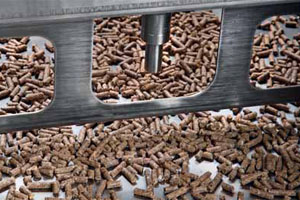Meta-analysis on pros and cons of wet-dry feeders

Using wet-dry feeders for growing-finishing pigs leads to better growth performance and water usage. This was the conclusion of ameta-analysis on wet-dry vs conventional feeders. The study helped Sureemas Nitikanchana and her colleagues at Kansas State University to obtain the biannual Pig Management Award, sponsored by Elanco Animal Health.
Wet-dry feeders can be described as feeders with a built-in water source. Several studies have shown that growing-finishing pigs fed using wet-dry feeders have had a better feed intake and gain, when compared to those fed using conventional dry feeders. Differences in feed efficiency, however, have proven to be inconsistent in trials. In addition, the availability of water within the feeders is reported to decrease the water usage and consequently reduce the manure volume. Therefore, the objective of the study was to perform a meta-analysis of available studies to evaluate the influence of the wet-dry feeders on growth performance, carcass traits, and water usage of growing-finishing pigs.
In total, 15 trials were used for the meta-analysis. Data was obtained by a search for records published through Kansas State University libraries.
Results
Table 1 shows the outcomes of the meta-analysis. Pigs fed with wet-dry feeders had a greater average daily gain as well as a better average daily feed intake when, compared with the pigs fed using conventional dry feeders, there was however no benefit in feed efficiency. As a result of improved growth rate, both final body weight and hot carcass weight of the pigs fed with wet-dry feeders were 3.2% greater.
For carcass traits, back fat was bigger and percentage lean meat was lower in pigs fed with wet-dry feeders. Carcass yield and loin depth was not different between each feeder type. Water usage for pigs using wet-dry feeders was 1.4 litres per pig per day, less than for pigs using conventional dry feeders.
Conclusions and discussion
The meta-analysis observed that pigs fed using wet-dry feeders indeed had an increased growth rate, feed intake, final body weight and hot carcass weight. However pigs fed with wet-dry feeders deposited more fat as indicated by greater back fat depth and lower percentage lean meat than those fed with conventional dry feeders.
Some data suggest a possible interaction between diet type (meal vs pellet) and feeder design. It is speculated that with conventional dry feeders, pigs fed pelleted diets had an improved efficiency, compared with those fed with meal diet, but no differences in efficiency were found between diet types when fed with wet-dry feeders.
In this analysis both types of feed (meal and pellets) were taken into account. As there were only three trials that used pelleted feed, it was impossible to detect any interactions. More data would be needed to investigate the effect of wet-dry feeders in combination with different types of diets.
References available on request.
This article is adapted from the oral paper ‘Meta-analysis comparing growth performance, carcass characteristics, and water usage of pigs fed using conventional dry or wet-dry feeders’, presented at the IPVS Congress 2012, Jeju, South Korea. The winning paper was co-authored by S.S. Dritz, M.D. Tokach, R.D. Goodband, J.M. Derouchy and J.L. Nielsen.
| 5th Pig Management Award The Pig Management Award was awarded during the 2012 IPVS Congress in Jeju Island, South Korea, for the fifth time. An international and unbiased jury picked the presentation from a shortlist of 13 non-commercial management papers, presented at the Congress. The long list had consisted of 122 submitted abstracts. The award is meant to recognise excellent science in pig management; the papers have to meet certain evaluation criteria, like that it has to apply globally; all farm sizes can implement practices outlined; there is a significant impact at farm level; information presented is clearly understood; and the paper addresses an industry need. Sureemas Nitikanchana (picture below), who received a sculpture created in the Netherlands, said she was very surprised to have won the prize as commonly not a lot of people dive into this subject. “My colleagues at K-State however always told me I was going to bring home the prize,” she said. She succeeds Dr Thierry Solignac, Coopagri, France, the 2010 winner. |







